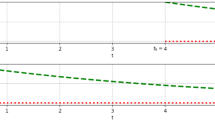Abstract
An \(n\)-dimensional economic model is considered that has a Cobb–Douglas production function on the infinite planning horizon such that the utility function is an integral-type functional with a discount and a logarithm-type integrant. It is assumed that all of the model’s amortization factors are equal to one another. The constructed optimum control contains \(n-1\) special segments that are described analytically. A special sweep procedure for consecutively solving two Cauchy problems on each segment is developed to find moments of switching between segments and the shape of the optimum trajectory. On the last segment, the optimum trajectory lies along a special ray; from the viewpoint of economy, this ray can be interpreted as the mode of equilibrium growth. A Pontrjagin maximum-principle problem with a special transversality condition is used to construct the optimum solution. Optimality is confirmed using the Kiselev theorem on sufficient conditions. Moving to problems of large dimensions considerably increases the number of technical difficulties. The description of the optimality verification procedure is therefore presented in detail for methodological reasons.
Similar content being viewed by others
REFERENCES
Yu. N. Kiselev, M. V. Orlov, and S. M. Orlov, ‘‘Boundary value problem of Pontryagin’s maximum principle in a two-sector economy model with an integral utility function,’’ Comput. Math. Math. Phys. 55 (11), 1779–1793 (2015).
Yu. N. Kiselev, M. V. Orlov, and S. M. Orlov, ‘‘Optimal resource allocation program in a two-sector economic model with an integral type functional for various amortization factors,’’ Differ. Equations 51 (5), 683–700 (2015).
Yu. N. Kiselev and M. V. Orlov, ‘‘Optimal resource allocation program in a two-sector economic model with a Cobb-Douglas production function,’’ Differ. Equations 46 (12), 1750–1766 (2010).
Yu. N. Kiselev and M. V. Orlov, ‘‘Optimal resource distribution program in a two-sector economic model with a Cobb-Douglas production function with distinct amortization factors,’’ Differ. Equations 48 (12), 1607–1622 (2012).
L. S. Pontryagin, V. G. Boltyanskii, R. V. Gamkrelidze, and E. F. Mishchenko, The Mathematical Theory of Optimal Processes (Fizmatgiz, Moscow, 1961; Wiley-Interscience, New York, 1962).
Yu. N. Kiselev, ‘‘Sufficient conditions of optimality in terms of constructions of the Pontryagin maximum principle,’’ in Mathematical Models in Economics and Biology (MAKS Press, Moscow, 2003), pp. 57–67 [in Russian].
S. M. Aseev and A. V. Kryazhimskii, ‘‘The Pontryagin maximum principle and optimal economic growth problems,’’ Proc. Steklov Inst. Math. 257 (1), 1–255 (2007).
D. A. Zyukin and I. E. Gurova, ‘‘Research of the level of usage of production factors in a pharmaceutical company based on the Cobb-Douglas function,’’ Sovremennye Nauchnye Issledovaniya i Innovatsii (Modern Scientific Researches and Innovations) [Electronic journal], No. 5 (61), 1–4 (2016) [in Russian].
V. A. Gnevesheva, ‘‘Employment forecast using the Cobb-Douglas function,’’ Znanie. Ponimanie. Umenie (Knowledge. Understanding. Skill), No. 1, 117–122 (2005) [in Russian].
A. M. Tarasyev and A. A. Usova, ‘‘Construction of a regulator for the Hamiltonian system in a two-sector economic growth model,’’ Proc. Steklov Inst. Math. 271 (1), 265–285 (2010).
Y. Iwasa and J. Roughgarden, ‘‘Shoot/root balance of plants: optimal growth of a system with many vegetative organs,’’ Theor. Popul. Biol. 25 (1), 78–105 (1984).
Funding
This work was supported by the Russian Foundation for Basic Research, project no. 18-31-00454.
Author information
Authors and Affiliations
Corresponding authors
Additional information
Translated by A. Muravnik
About this article
Cite this article
Kiselev, Y.N., Orlov, M.V. & Orlov, S.M. Multidimensional Economic-Growth Models with an Integral Utility Function. MoscowUniv.Comput.Math.Cybern. 44, 73–86 (2020). https://doi.org/10.3103/S0278641920020041
Received:
Revised:
Accepted:
Published:
Issue Date:
DOI: https://doi.org/10.3103/S0278641920020041



